-
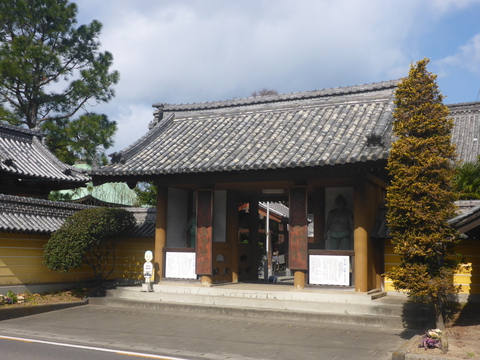
1Kaiganji Temple
Kaiganji Temple is located in the Byobugaura area of Tadotsu, a town on the Seto Inland Sea coast. Its vast grounds are divided into a coastal zone, where the Main Hall and the monks’ quarters stand, and an inland zone with structures such as the Okunoin and Daishi halls. A public road and the JR Yosan railway line pass through the latter area. Visitors enter the temple through the Niomon, or Gate of the Guardian Kings. Gates such as these are usually flanked by a pair of statues depicting Buddhist deities, but at Kaiganji the guardians are sumo wrestlers instead. According to legend, the temple was established in 807 by the Buddhist priest Kukai (774–835), the founder of the Shingon school and the originator of the Shikoku 88-Temple Pilgrimage, upon his return from studies in China. Kukai may have chosen the location for Kaiganji because his mother, Lady Tamayori, resided here around the time when Kukai was born. The assumed site of her residence now hosts the Butsumoin (“mother of Buddha”) Hall, whereas the temple itself is said to have been built on the site of a hut Tamayori had prepared for giving birth. Several places on the grounds afford views of the island-dotted sea to the north. One such viewpoint is the beach behind the Main Hall; another is the Okunoin Hall on a nearby hill, which can be climbed in about 15 minutes.
More details
-
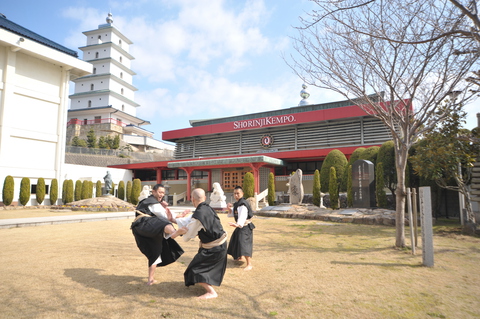
2Kongo Zen Sohonzan Shorinji Temple
Kongo Zen Sohonzan Shorinji Temple in the town of Tadotsu is the headquarters of Kongo Zen, a religion founded in 1947 by So Doshin (1911–1980). A follower of Kongo Zen seeks to “establish one’s self” and achieve “mutual happiness for oneself and others” through training centered on Shorinji Kempo, a method believed to strengthen both the body and the spirit. Shorinji Kempo is focused on martial techniques that So ordered and organized based on what he had learned in China, where he had been stationed during World War II. So’s teachings urge practitioners to use their abilities for the benefit of others and for the greater good, to achieve a peaceful society rich in both the material and the spiritual sense. Shorinji Kempo is practiced throughout Japan and in 38 other countries around the world.
Most of the facilities at Kongo Zen Sohonzan Shorinji are reserved for practitioners and are not open to the public, but walking through the red Niomon (Gate of the Guardian Kings) to the Tennoden, the main building, is permitted. At the Tennoden visitors can view a statue of So Doshin and a stone monument that commemorates the bonds between Shorinji Kempo and the Shaolin Temple in Henan, China, the place where the teachings of Giwamon Ken (one of the Shaolin martial arts) were passed on to So. The temple’s annual Daruma Festival in October is also open to anyone interested in the ways of Shorinji Kempo.More details
-
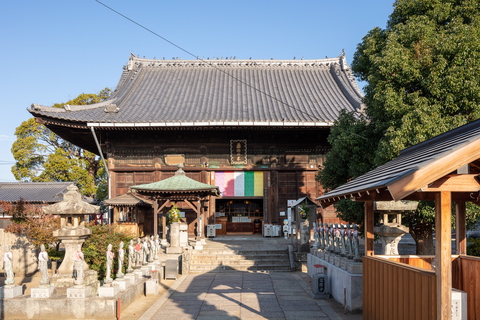
3Doryuji Temple
Doryuji Temple in the town of Tadotsu belongs to the Shingon school of Buddhism and is the 77th sacred site on the 88-temple Shikoku Pilgrimage. The temple traces its history to the year 712 and is noted for its 255 bronze statues of Kannon, the bodhisattva of compassion, which line the main approach all the way to the main hall. Some of these statues represent the principal deities of famous temples elsewhere in Japan, whereas others are dedicated to a specific purpose such as praying for traffic safety or for the souls of stillborn children. Equally notable is the temple’s main deity, Yakushi or the Buddha of medicine and healing. This particular Yakushi statue is believed to have the power to cure ailments related to the eyes, as exemplified by the story of an Edo-period (1603–1867) character named Kyogoku Samanomiyatsuko. The blind Kyogoku’s sight is said to have been restored after he prayed at Doryuji. This miracle inspired him to study medicine, especially vision-related ailments, and he eventually came to serve high-ranking samurai lords as their personal physician. Kyogoku’s tomb can be found in the Sentokuinden Hall at Doryuji.
More details
-
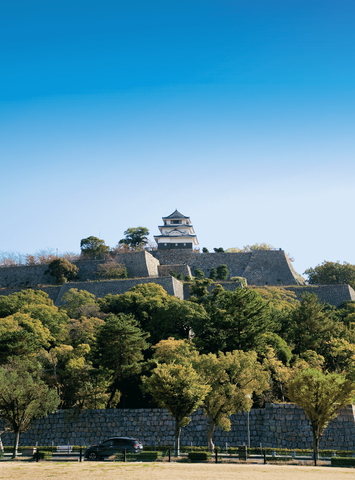
4Marugame Castle
Marugame Castle overlooks the city of Marugame, the largest population center in western Kagawa Prefecture, from a hill called Kameyama. It is one of only 12 castles in Japan with a surviving wooden keep from the Edo period (1603–1867). The original castle was built between 1597 and 1602 by the Ikoma family, lords of Sanuki province (present-day Kagawa Prefecture). It switched hands from one daimyo lord to another and was modified and rebuilt several times over the centuries, notably by the Kyogoku family that controlled it throughout most of the Edo period. The castle was officially decommissioned after the Meiji Restoration of 1868, which ended samurai rule over Japan. Its distinctive three-story keep dates to 1660 and is, at 15 meters high, the smallest of the 12 remaining structures of its kind in the country. The keep, along with the Ote Ichino and Ote Nino gates, is designated an Important Cultural Property. Besides its buildings, the castle is noted for its imposing ramparts, which are thought to have made the fortress extremely difficult to invade. The ramparts, the highest of which measures 22 meters from top to bottom, form four terraces between the inner moat and the keep.
More details
-
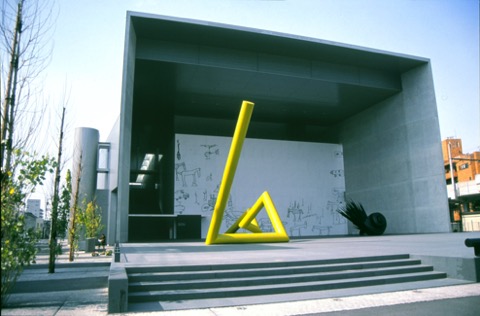
5Marugame Genichiro-Inokuma Museum of Contemporary Art
A native of Kagawa, Inokuma Genichiro (1902–1993) was an artist who grew up in Marugame, studied in Tokyo and Paris, and afterwards spent long periods working in New York and Hawaii. Having been mentored by Henri Matisse (1869–1954) and having interacted with, among others, Mark Rothko (1903–1970), Isamu Noguchi (1904–1988), and Charles (1907–1978) and Ray (1912–1988) Eames, Inokuma is known for his multidisciplinary and innovative style, which he expressed mainly through painting but also through sculpture, illustration, and design.
Located in front of Marugame Station, the Marugame Genichiro-Inokuma Museum of Contemporary Art or MIMOCA mainly exhibits pieces from its collection of some 20,000 Inokuma artworks, all donated by the artist himself. Its special exhibitions focus on the work of contemporary artists from both Japan and elsewhere. Several such exhibitions are held every year.
The museum building was designed by the architect Taniguchi Yoshio (1937–), who also redesigned the Museum of Modern Art in New York City for its reopening in 2004. The MIMOCA is distinguished by its box-like shape and minimalist entrance, in front of which three of Inokuma’s sculptures and a giant mural welcome visitors. These elements help the building blend in with its urban surroundings, whereas the high ceiling, plain lighting, and abundant use of right angles combine for an understated interior that does not distract from the artworks.More details
-
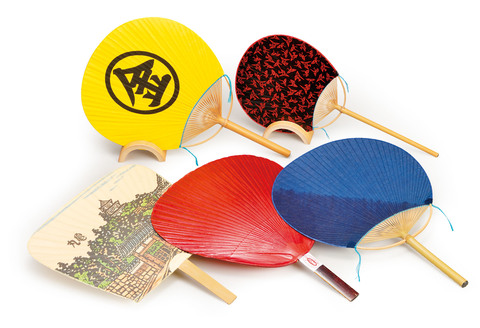
6Marugame Uchiwa
Marugame uchiwa (fans) date back to early in the Edo period, when these distinctive fans were first made as souvenirs for pilgrims who came to Konpira Shrine. They typically had the character for “gold” inscribed on them, which is the first Chinese character in the name of Konpira Shrine. The stamping of the gold mark on the fan was both a reminder of the name of the place one had visited and also seen as bringing good fortune to the receiver.
Marugame uchiwa now account for 90% of all fans produced in Japan, and over one billion are made each year. In 1997 the Japanese government officially recognized them as traditional craft products.
The process of making them is complex, with forty-seven separate steps involved, and the craftsmen mostly perform these by hand. Throughout the history of making the fans, many distinctive shapes were invented, not only for the purpose of cooling oneself in the summer but also for cooling food, starting fires, swatting insects, and as fashion statements and decorations. This tradition continues to evolve today, connecting the past with the present.
Please see the Marugame Uchiwa website for further information on these lovely fans. You can design your own fan in a fan-making experience. For details, visit the website: https://marugameuchiwa.jpMore details
-
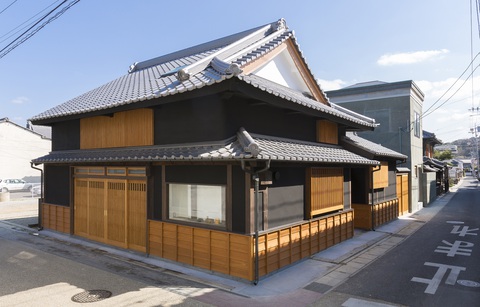
7Utazu Komachi
Utazu has been a prosperous port town since the Muromachi period (1336–1573). A part of the old town south of the town hall is called Komachi, where many historic shrines, temples, and traditional merchants’ family homes (machiya) can still be seen along the streets. The long, thin merchant’s homes, which are distinguished by their narrow entrances, were mainly built in the mid-1800s and are joined by newer Western-style buildings here and there. Among the nine Buddhist temples in Komachi, the most notable is Goshoji, the 78th sacred site on the 88-temple Shikoku Pilgrimage. Another notable religious site is Ubushina Shrine, a Shinto sanctuary with more than 1,200 years of history. Komachi is best explored on foot, with a stop or two at the old shops that sell ohagi, a traditional sweet treat made from mochi rice cake and red bean paste. The neighborhood attracts crowds every March, when a festival is held to celebrate Hinamatsuri (Dolls Festival).
More details
-

8Shikoku Aquarium
Situated in Utazu Seaside Park is the Shikoku Aquarium, which exhibits roughly 400 marine species that live in the sea surrounding Shikoku. Its large tanks give visitors panoramic views of what goes on in the depths of the Seto Inland Sea and the Pacific Ocean, and informative displays focus on Shikoku’s waterways, including the Shimanto and Niyodo rivers. The main floor-to-ceiling tank highlights the Japanese horse mackerel (ma-aji) and about 20 other species of fish that travel on the warm Kuroshio (Japan Current), which flows north along the Pacific coast of Japan and is largely responsible for the mild climate along this coast. The nearby shark tank features scalloped hammerhead sharks that can be viewed from below. Further highlights are the Uzushio tank, which recreates the sea underneath the famed tidal whirlpools of the Naruto Strait on the east side of Shikoku, and a dolphin pool that, when seen from the aquarium’s Sunset Deck, appears to blend in with the Seto Inland Sea behind. The view of the pool can be particularly memorable at dusk, when the jumping dolphins create a dramatic scene against the backdrop of the setting sun.
More details
-
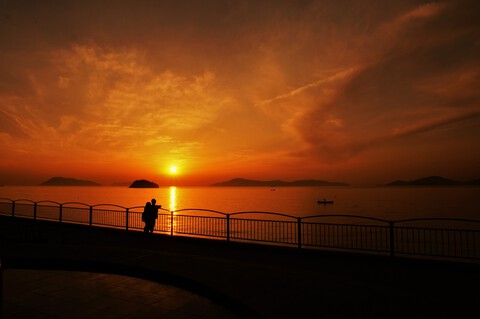
9Utazu Seaside Park
Utazu Seaside Park is located in the northern part of the town of Utazu, facing the Seto Inland Sea. The town flourished as a center of salt manufacturing from the eighteenth century onward, becoming one of the top producers in Japan. The industry was shut down in 1972, and Utazu Seaside Park opened on the former site of the salt evaporation ponds in 1989. Utazu’s history of salt production is commemorated in one part of the park, where a salt field has been reconstructed to remind visitors of the place’s past. Other sites of interest include the Utazu Umihotaru building, housing a cafe and a spacious playground for children. A recent addition to the park is the Shikoku Aquarium, which opened in 2020 and features displays focused on marine life in the seas around Shikoku. Utazu Seaside Park is also famous for its views of the island-dotted Inland Sea. Off the coast lie the Shiwaku Islands, including Ushijima and Honjima, beside which the imposing Seto Ohashi Bridge stretches toward Okayama on the Honshu side. Many visitors come to admire this landscape in the evening, both to see the sun set into the sea and to watch the bridge lit up after dark.
More details
-
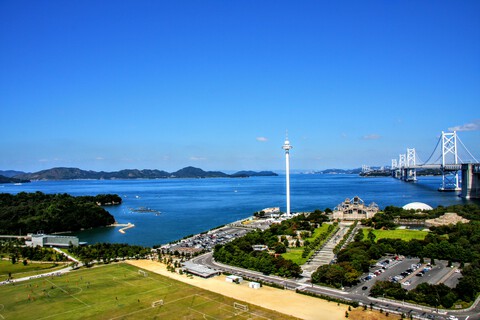
10Seto Ohashi Commemorative Park
The building of the Seto Ohashi Bridge was a painstaking process that lasted nearly 10 years. Visitors can study this history in detail at Seto Ohashi Commemorative Park near the Shamijima district of Sakaide, at the foot of the bridge on the Shikoku side. Opened in 1988, the park is the former site of an open-air exhibition that was held to celebrate the completion of the bridge that same year. The free-to-enter Seto Ohashi Commemorative Hall in the park details the challenges and triumphs of the construction project, while the playgrounds and sports fields nearby offer plenty of space for play and recreation. Another place of interest is the Hama Ritsurin garden, designed by the sculptor Nagare Masayuki (1923–2018), whose giant rock sculptures provide an interesting contrast with the bridge.
More details
-
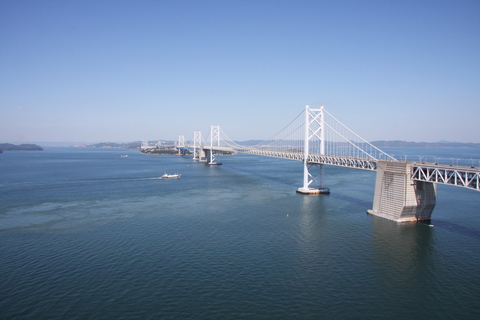
11Seto Ohashi Bridge
A wonder of modern architectural engineering, the 13-kilometer Seto Ohashi Bridge connects Okayama Prefecture on the main island of Honshu with Kagawa Prefecture in Shikoku. The imposing structure actually consists of 10 connected two-tiered bridges; the upper deck is for cars and the lower is for trains. As such, Seto Ohashi is the world’s longest double-decked bridge. It was built over a period of 10 years, from 1978 to 1988—a painstaking process that visitors can learn more about at Seto Ohashi Memorial Park in Sakaide, at the foot of the bridge on the Shikoku side. A free museum details the challenges and triumphs of the construction project, while the 108-meter Seto Ohashi Tower offers views over the entire length of the bridge and the islands of the Seto Inland Sea on both sides of it. Driving across the bridge takes about 15 minutes, as does the train trip between Utazu Station on the Shikoku side and Kojima Station in Okayama.
More details
-
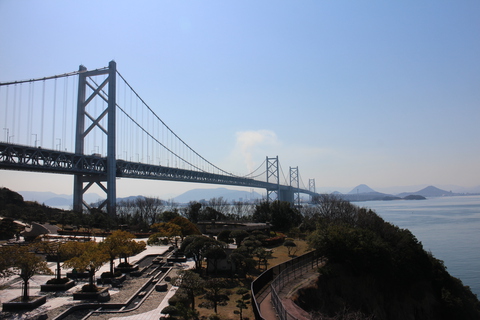
12Yoshima
Yoshima is a small island in the Shiwaku chain located just under the middle span of the Seto Ohashi Bridge in the Seto Inland Sea, a 20-minute drive from the city of Sakaide. Its position underneath the bridge that connects Shikoku with the main island of Honshu makes Yoshima a popular lookout, as viewing the bridge from below is a good way to grasp its monumental size. The island is also the starting point for the Seto-Ohashi Bridge Sky Tours, which take visitors to the top of one of the bridge towers, 175 meters above sea level. Less vertigo-inducing but equally popular is the Yoshima parking area, a highway rest stop where eateries offer Sanuki udon noodles and light meals, and souvenir shops sell snacks, sweets, and other local specialties from the island of Shikoku. The parking area’s main building includes a scenic lookout from which visitors can admire the island-dotted sea and the ships passing by.
More details
-
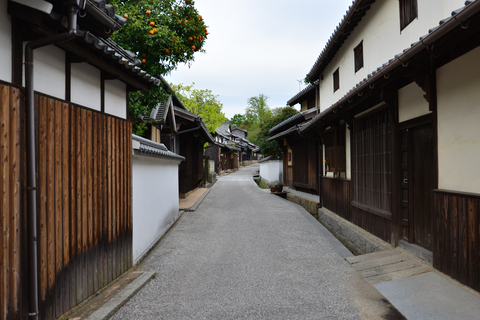
13Kasashima(Honjima island)
Honjima: A Hub of Maritime History
The island of Honjima is located in the Seto Inland Sea off the coast of Kagawa Prefecture, west of the Seto Ohashi Bridge, and can be reached in 35 minutes by ferry from the city of Marugame. Honjima is the second-largest of the 28 Shiwaku islands and the most populous, though only about 400 people live on it. The island has an illustrious history, having been a prosperous seafaring center from the sixteenth to the eighteenth century.
This history is on display in the port town of Kasashima, in the eastern part of Honjima, where some 100 buildings constructed mainly between the beginning of the nineteenth century and the early twentieth century survive. Surrounded by hills on three sides, the town occupies the base of a narrow valley and is laid out in a grid pattern. Its passageways are lined with traditional merchant family homes, some modest, others the grand estates of households whose members built their fortunes in shipbuilding and carpentry. Kasashima is designated a Preservation District for Groups of Traditional Buildings. Three of these buildings are open to the public, including the Sanagi House, a merchant’s home that dates to the latter half of the Edo period (1603–1867). The house includes a facility where visitors can learn about the history and preservation of the town. Its distinctive exterior walls are decorated with namako, a diamond pattern achieved with thick white plaster joints laid over black tiles, originally developed to protect earthen walls from water.
The Kasashima townscape can be viewed from above by climbing 15 minutes from the bottom of the valley to the summit of the 110-meter Mt. Tomiyama. Here, a scenic view spot affords vistas over the settlement and toward the island-dotted sea. The entire length of the Seto Ohashi Bridge is also visible from this point.More details
-
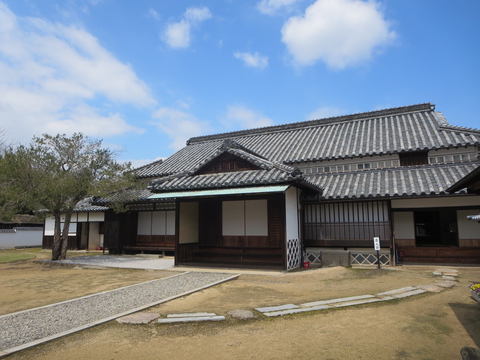
14Shiwaku Kinbansho
Shiwaku Kinbansho is the former government office of the Shiwaku archipelago, and it’s located at Honjima island which have been center of the archipelago.
The Shiwaku archipelago is a chain of 28 small islands between Okayama Prefecture and Kagawa Prefecture.
This area have been vital for trade and maritime traffic since ancient times, and furthermore, the inhabitants were experts in navigating the often-perilous currents. Thus, they became known as the Shiwaku Navy in the sixteenth century.
As a reult, these mariners were held in high regard by some of the most powerful warlords of the time in Japan.
Moreover the Shiwaku archipelago was given special permission to self-govern by the early seventeenth century, and the island’s leaders, known as “elders”, were in charge of running the government.
Its government office was Shiwaku Kinbansho.More details
-
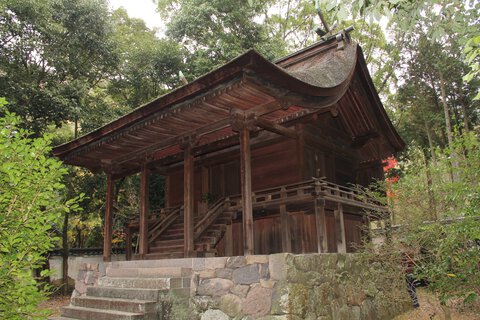
15Kandani Shrine
Kandani Shrine has a bright red worship hall (haiden) rebuilt in 1930, and behind it the Main Sanctuary, a smallish wooden structure that is one of the oldest extant shrine buildings in Japan. Although unembellished, it is historically significant. Repairs conducted in the Taisho era (1912–1926) led to the discovery of a number of wooden markers detailing the history of the building. The oldest of these ridge tags (munafuda), which describe the timing and circumstances of repairs and reconstruction work undertaken on a structure, revealed that the present Main Sanctuary was constructed in 1219. The building sits on a platform made of natural stones and its curved roof, covered with layers of hinoki cypress bark shingles, extends over the wooden steps in front of the structure. The extension is supported by four square pillars. These architectural features are typical of the Kamakura period (1185–1333) and contributed to the designation of the Main Sanctuary as a National Treasure in 1955. The shrine itself is thought to be even older: the sanctuary’s own records indicate that it was founded in the year 812. It possesses a number of historic documents and other artifacts, including a Kamakura-period statue depicting a Shinto guardian deity (zuijin), though these treasures are displayed only on select occasions. The shrine is located near the banks of the Kandani River in the shadow of Mt. Shiramine, one of the five peaks of the Goshikidai Plateau between the cities of Takamatsu and Sakaide.
More details
-
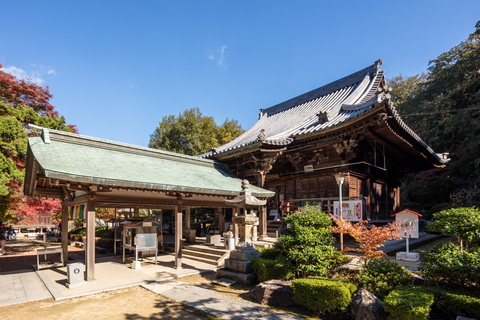
16Shiromineji Temple
Shiromineji Temple stands on Mt. Shiramine, one of the five peaks of the Goshikidai Plateau, between the cities of Takamatsu and Sakaide. As the 81st temple on the Shikoku 88-Temple Pilgrimage, it receives a steady stream of pilgrims who come to say their prayers at the temple’s many mountainside halls. Six of these buildings, some of which date back to the sixteenth and seventeenth centuries, are dedicated to Buddhas represented by one or several of the 12 animals of the Chinese zodiac. The Buddha corresponding to the year one was born in is considered that person’s protector deity. Small statues are placed in front of the halls to help visitors find the sanctuary that stands for their zodiac sign.
Another interesting structure at Shiromineji is the Tonshoji Hall, which consists of a worship hall (haiden) up front and, behind it, three smaller shrines connected to the worship hall with corridors—a rare architectural solution that is not employed anywhere else in Japan. The sanctuaries on the left and right are dedicated to a Shinto kami and a Buddhist deity respectively, while the one in the middle enshrines Emperor Sutoku (1119–1164), whose defeat in a power struggle at court led to him being exiled to this remote region long ago. Emperor Sutoku died here and is buried in a modest grave next to Shiromineji.
After touring the temple grounds, visitors can walk or drive a few hundred meters back along the road from the Shiromineji entrance to the Shiramine Park Center. The center has a café and a scenic lookout, which offers impressive views over the city of Sakaide, Seto Ohashi Bridge, and the perfectly cone-shaped Mt. Iino, also known as “the Mt. Fuji of Sanuki” (Sanuki being the old name for Kagawa Prefecture). Further up the mountain is Shiramine Onsen, hot springs where the views from the open-air tub rival those of the aforementioned scenic lookout.More details
